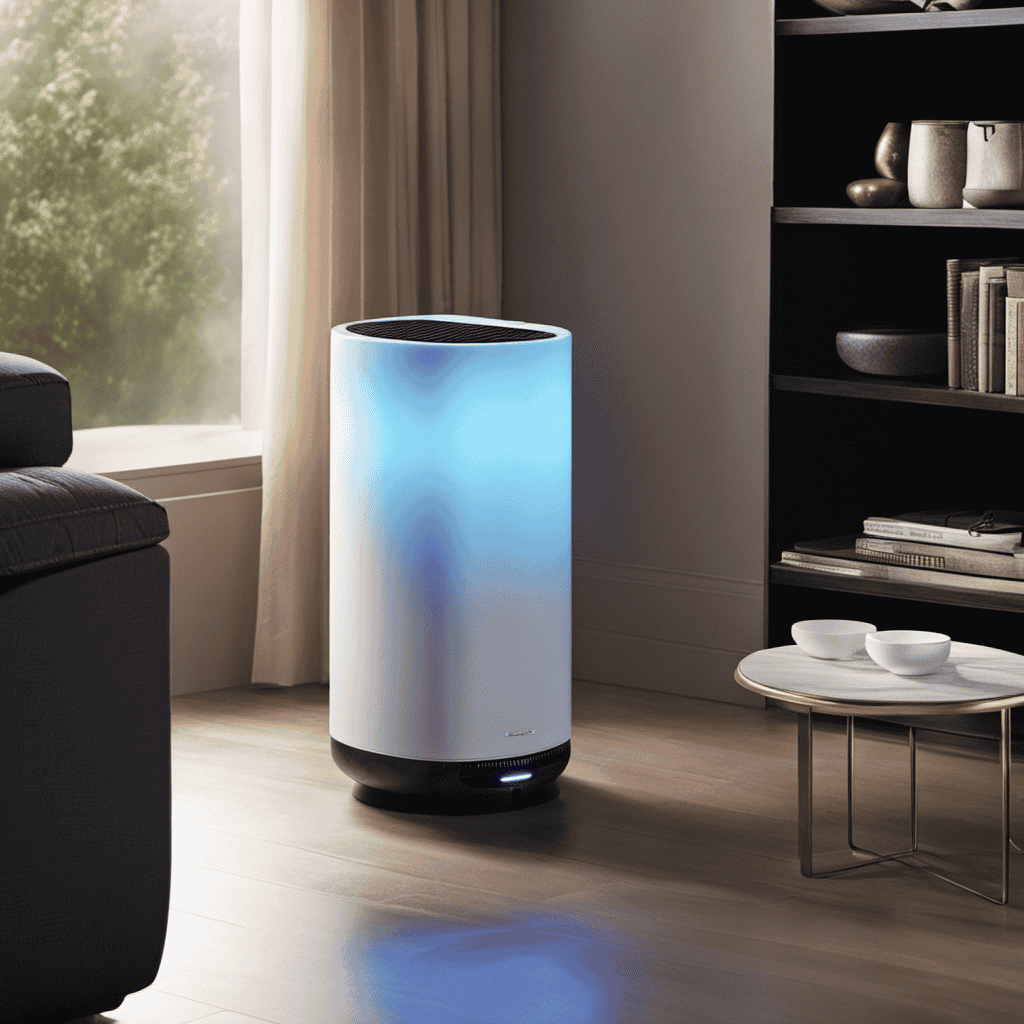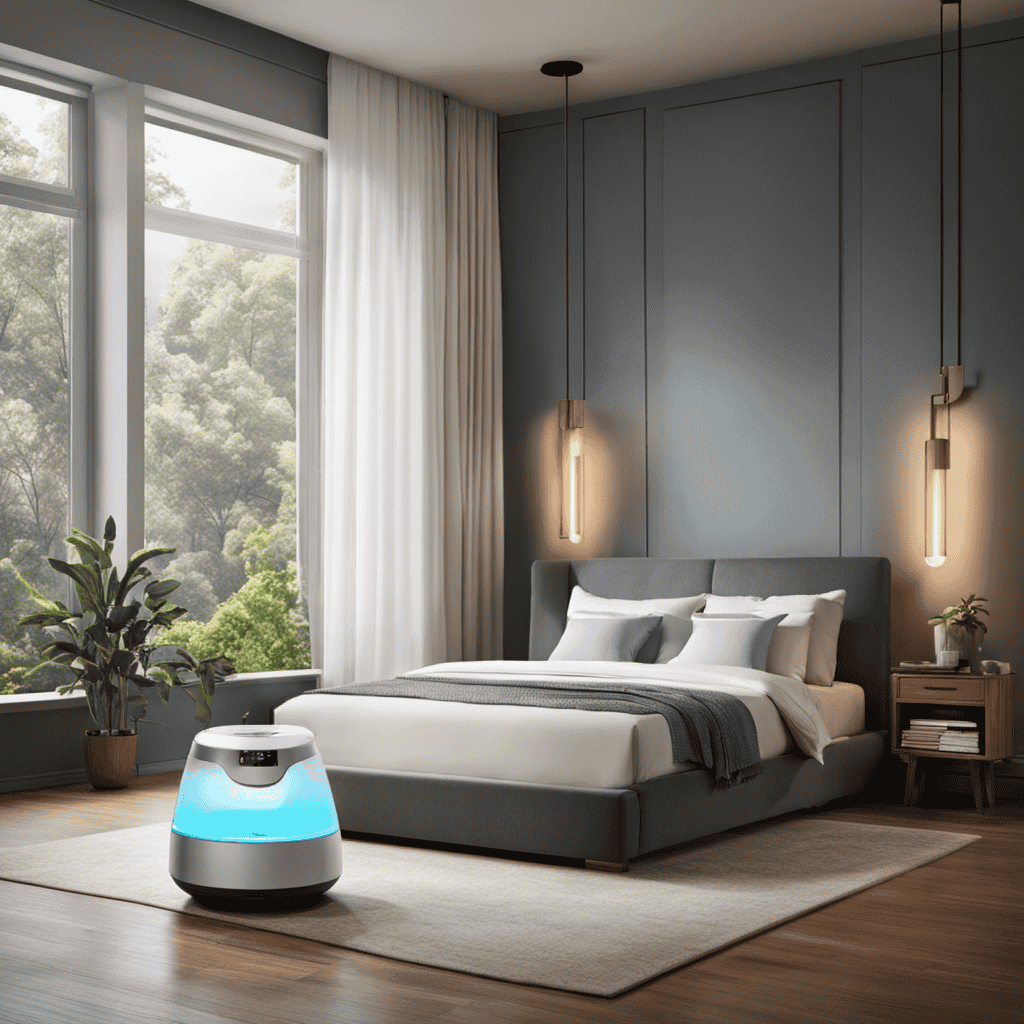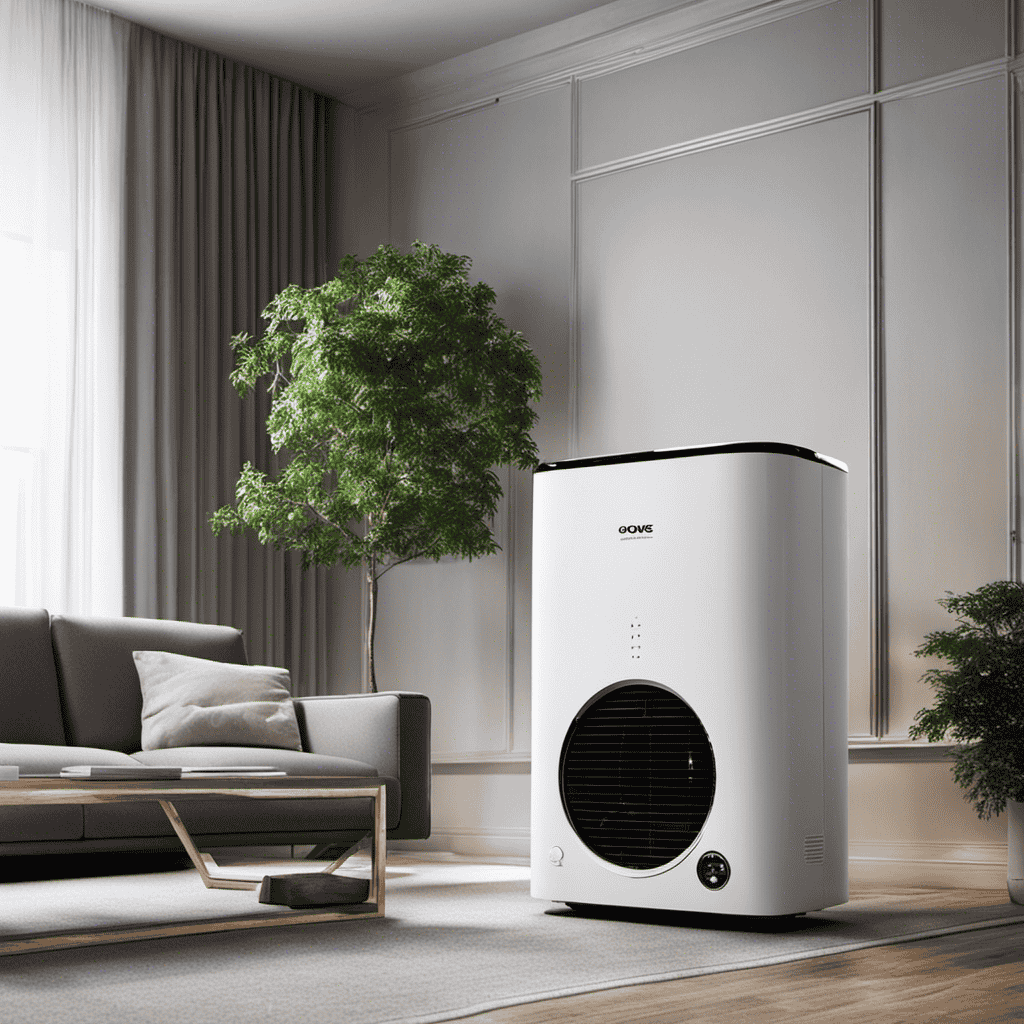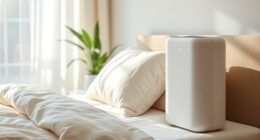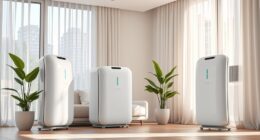I’ve always been curious about the function of the ‘ionizer’ button on my air purifier, which is why I opted to investigate further.
Turns out, an ionizer is a feature that helps improve air quality by releasing negatively charged ions into the air. These ions attach themselves to airborne particles, causing them to become heavy and fall to the ground, effectively removing them from the air we breathe.
In this article, we’ll delve deeper into the science behind ionizers, how they work in air purifiers, and the benefits of using one.
So, let’s get started!
Key Takeaways
- Ionizers release negatively charged ions into the air, which attach to airborne particles and make them heavier, causing them to fall to the ground.
- Ionizers help remove harmful particles from the air, reduce the presence of allergens, and improve overall air quality.
- Proper ventilation is essential to prevent ozone accumulation, as ionizers can generate ozone, which can be harmful in high concentrations.
- When choosing and maintaining an air purifier with an ionizer, it is important to research ionizer technology, consider room size, look for additional filtration features, and ensure optimal performance and safety through regular cleaning and maintenance.
The Science Behind Ionizers
The science behind ionizers is fascinating. Ionizers are a key component of air purifiers and play a crucial role in improving air quality.
The ionization process involves the release of negatively charged ions into the air. These ions attach themselves to airborne particles such as dust, pollen, and pet dander, making them heavier and causing them to fall to the ground or become trapped on surfaces.
This process effectively removes these particles from the air we breathe, resulting in cleaner and fresher indoor air.
Additionally, ionizers can also neutralize harmful pollutants like bacteria, viruses, and mold spores by breaking down their molecular structure. This helps to reduce the risk of respiratory illnesses and allergies, making ionizers an essential tool for improving overall air quality.
How Ionizers Work in Air Purifiers
One way ionizers work in air purifiers is by releasing charged particles into the air. These charged particles, called ions, attach themselves to airborne particles such as dust, pollen, and smoke. By doing so, the ions make these particles heavier and cause them to fall to the ground or stick to surfaces, effectively removing them from the air we breathe.
This process, known as ionization, helps to improve the overall air quality in a room. However, it is important to understand that ionizers can also produce ozone as a byproduct. Ozone, in high concentrations, can be harmful to our health, causing respiratory issues and exacerbating asthma symptoms.
Therefore, it is crucial to choose an air purifier with ionization carefully and ensure it meets safety standards to minimize any potential side effects.
Understanding the Ionization Process
When it comes to improving air quality, ionization has proven to be an effective method. Ionizers work by releasing negative ions into the air, which attach to pollutants and allergens, causing them to become heavy and fall to the ground.
However, it is important to consider safety precautions with ionizers, as they can produce ozone, which can be harmful in high concentrations.
Ionization Benefits Air Quality
Did you know that ionization actually helps improve the air quality in your home?
Ionizers, a type of air purifier, release ions into the air that attach themselves to harmful particles such as dust, pollen, and pet dander. These ions have a charge that causes the particles to become heavy and fall to the ground or stick to surfaces, thus removing them from the air.
This process is especially beneficial for those with allergies, as it helps to reduce the presence of allergens in the air. By removing these particles, ionizers can help alleviate symptoms such as sneezing, coughing, and itchy eyes.
Additionally, ionization has been shown to have positive effects on overall health, as it can reduce the presence of pollutants and improve the overall air quality in your home.
How Ionizers Work
Ionization helps improve air quality by releasing ions that attach to harmful particles, causing them to become heavy and fall to the ground or stick to surfaces.
Ionizers, also known as air ionizers or negative ion generators, are devices that use this process to purify the air. These devices work by emitting a stream of negatively charged ions into the air.
These ions attach to positively charged particles, such as dust, pollen, and smoke, causing them to become heavier and eventually fall to the ground or stick to surfaces. This can be beneficial for individuals who suffer from allergies or respiratory issues, as it helps to remove these irritants from the air.
Safety Considerations With Ionizers
To ensure your safety, it’s important to be aware of potential hazards associated with using ionizers. While ionizers can be beneficial in purifying the air, they also have the potential to generate ozone, which can pose health risks. Here are four important considerations:
-
Ozone generation: Ionizers work by emitting negative ions into the air, which can interact with pollutants and neutralize them. However, this process can also lead to the production of ozone as a byproduct.
-
Ozone concentration: High levels of ozone can irritate the respiratory system and worsen existing respiratory conditions such as asthma. It’s crucial to monitor the ozone concentration in the air and ensure it remains within safe limits.
-
Ventilation: Proper ventilation is essential when using ionizers to prevent the accumulation of ozone indoors. Opening windows or using exhaust fans can help maintain a healthy air quality.
-
Manufacturer guidelines: Always follow the manufacturer’s instructions for the safe use of ionizers. This includes recommended usage time, placement in the room, and maintenance procedures.
Benefits of Using an Ionizer in an Air Purifier
You’ll love the benefits of using an ionizer in your air purifier.
An ionizer is a feature that helps improve the effectiveness of your air purifier by releasing negatively charged ions into the air.
These ions attach themselves to particles in the air, such as dust, pollen, and pet dander, causing them to become heavier and fall to the ground or stick to surfaces, instead of floating in the air.
This process, known as ionization, helps to remove these particles from the air, making it cleaner and healthier to breathe.
Additionally, ionizers can also help to neutralize odors and remove bacteria and viruses from the air.
This makes the air in your home fresher and reduces the risk of respiratory issues.
Common Misconceptions About Ionizers
One common misconception about ionizers is that they release harmful ozone into the air. This is not entirely true. While it is correct that ionizers generate ions, which can react with oxygen to form ozone, modern air purifiers with ionizers are designed to minimize this potential risk. Here are four important points to consider:
-
Advanced ionizers: Air purifiers nowadays use advanced ionization technologies that produce minimal amounts of ozone, well below the safety limits set by regulatory agencies.
-
Ozone-free options: Many air purifiers now offer ozone-free ionization, utilizing alternative technologies like bipolar ionization or needlepoint ionization, which do not produce ozone.
-
Safety features: Reputable air purifier brands incorporate safety features such as ozone sensors and automatic shut-offs to ensure ozone levels remain within safe limits.
-
Third-party certifications: Look for air purifiers that have been tested and certified by independent organizations, such as the California Air Resources Board (CARB), to verify their ozone emissions are within acceptable levels.
Understanding these facts can help dispel the common misconceptions associated with ionizers and ensure you make an informed decision when choosing an air purifier with ionization capabilities.
Potential Side Effects of Ionizers
Understanding the potential side effects of ionizers is important when considering their use in your home. While ionizers are often included in air purifiers to improve indoor air quality, it is essential to be aware of the potential risks and long-term effects associated with their use.
Ionizers work by releasing negatively charged ions into the air, which attach to particles and allergens, causing them to become heavy and fall to the ground. While this can be beneficial for removing pollutants from the air, there are some potential side effects to consider.
One potential risk of ionizers is the production of ozone. Ozone is a harmful gas that can irritate the respiratory system and worsen conditions such as asthma and allergies. It is important to choose an ionizer with low ozone emissions to minimize this risk.
Another potential long-term effect of ionizers is the accumulation of particles on surfaces in your home. The charged particles released by ionizers can settle on furniture, walls, and other surfaces, creating a layer of dust that needs to be regularly cleaned.
To summarize, while ionizers can be effective in improving indoor air quality, it is crucial to weigh the potential risks and long-term effects. Choosing a low-ozone emitting ionizer and being mindful of dust accumulation can help mitigate these concerns.
| Potential Risks | Long-Term Effects |
|---|---|
| Production of ozone | Accumulation of particles on surfaces |
Choosing the Right Air Purifier With an Ionizer
After learning about the potential side effects of ionizers, it’s important to make an informed decision when choosing an air purifier with ionizer technology. Here are four key factors to consider:
-
Research the ionizer technology: Look for air purifiers that use advanced ionizer technology, such as bipolar ionization or needlepoint ionization. These technologies are designed to effectively neutralize airborne pollutants without producing harmful byproducts.
-
Consider the size of the room: Determine the square footage of the room where you plan to use the air purifier. Choose a purifier that is suitable for that size to ensure optimal performance.
-
Look for additional filtration features: Some air purifiers with ionizers also incorporate other filtration technologies, such as HEPA or activated carbon filters. These additional features can enhance the overall air cleaning process.
-
Check for certifications and ratings: Look for air purifiers that have been independently tested and certified by reputable organizations, such as the Association of Home Appliance Manufacturers (AHAM) or the California Air Resources Board (CARB). These certifications ensure that the purifier meets certain performance and safety standards.
Maintenance and Cleaning of Ionizers in Air Purifiers
When it comes to maintaining and cleaning ionizers in air purifiers, regular maintenance is essential to ensure optimal performance. The ionizer is a key component of an air purifier that helps to remove harmful particles from the air by emitting negatively charged ions. Over time, the ionizer can become dirty and less effective in purifying the air. To keep the ionizer functioning properly, it is important to clean it regularly. This can be done by following the manufacturer’s instructions, typically involving wiping the ionizer with a soft cloth or brush. Additionally, it is recommended to replace the ionizer every few years to ensure maximum efficiency. By taking proper care of the ionizer, you can ensure that your air purifier continues to provide clean and healthy air for you and your family.
| Maintenance Tips | Cleaning Process |
|---|---|
| Clean regularly | Follow manufacturer’s instructions |
| Replace ionizer every few years | Wipe with a soft cloth or brush |
| Check for any clogs or blockages | Use mild detergent if necessary |
| Keep the air purifier in a clean and dust-free environment | Allow the ionizer to dry completely before reassembling |
Comparing Ionizers With Other Air Purification Technologies
When it comes to comparing air purification technologies, I find it helpful to consider the differences between ionizers and HEPA filters, ionizers and UV-C technology, and ionizers and activated carbon.
Firstly, HEPA filters are known for their ability to trap small particles and allergens, making them a popular choice for those with respiratory issues. On the other hand, ionizers work by releasing negatively charged ions into the air, which attach to particles and cause them to clump together, making them easier to remove with a filter.
Secondly, UV-C technology uses ultraviolet light to kill bacteria, viruses, and mold spores, providing an additional layer of protection against harmful pathogens.
Lastly, activated carbon filters are effective at removing odors, gases, and chemicals from the air, thanks to their porous structure and adsorption capabilities.
Ionizers Vs. HEPA Filters
The ionizer on an air purifier helps to remove airborne particles, while HEPA filters trap them. Here is a comparison between ionizers and HEPA filters:
-
Effectiveness: Ionizers use charged ions to attract and neutralize airborne particles, but they may not be as effective as HEPA filters in removing smaller particles such as allergens and viruses.
-
Maintenance: HEPA filters need to be replaced regularly, while ionizers require cleaning to remove accumulated particles.
-
Ozone Generation: Ionizers can potentially generate ozone as a byproduct, which can be harmful to human health. On the other hand, HEPA filters do not produce any ozone.
-
Noise: HEPA filters typically operate silently, while some ionizers may produce a faint buzzing sound.
In conclusion, while both ionizers and HEPA filters have their advantages, HEPA filters are generally considered more effective and safer for air purification.
Now, let’s explore how ionizers compare to UV-C technology.
Ionizers Vs. UV-C Technology
Ionizers and UV-C technology both have their advantages and drawbacks in terms of effectiveness and safety.
Ionizers use charged ions to attract and remove particles from the air. They are effective in capturing small particles like allergens and dust, but they may produce ozone as a byproduct, which can be harmful to human health.
On the other hand, UV-C technology uses ultraviolet light to kill bacteria, viruses, and mold spores. It does not produce ozone, making it safer for indoor use. However, UV-C technology may not be as effective in capturing larger particles like pet dander and pollen.
When comparing ionizers to ozone generators, it is important to note that ionizers are generally considered safer as they produce less ozone. Additionally, in comparison to electrostatic precipitators, ionizers are typically more affordable and require less maintenance.
Ionizers Vs. Activated Carbon
Activated carbon is a popular choice for improving indoor air quality because it can effectively remove odors and volatile organic compounds (VOCs) from the air. It compares favorably to other air purifier technologies in several ways.
-
Activated carbon vs. ozone generation: Ozone generators release ozone into the air, which can be harmful to human health. In contrast, activated carbon adsorbs odors and VOCs without producing any harmful byproducts.
-
Activated carbon vs. ionizers: Ionizers work by releasing negatively charged ions into the air, which attach to airborne particles and cause them to fall to the ground. However, ionizers do not remove odors or VOCs. Activated carbon, on the other hand, can effectively trap these pollutants.
-
Activated carbon vs. electrostatic precipitators: Electrostatic precipitators use an electric charge to attract and collect airborne particles. While they can be effective in capturing larger particles, they may not be as effective in removing odors and VOCs as activated carbon.
Overall, activated carbon is a versatile and effective air purifier technology that can target and eliminate odors and VOCs, making it a valuable addition to any indoor environment.
Tips for Maximizing the Effectiveness of Ionizers in Air Purifiers
To get the most out of ionizers in air purifiers, it’s important to follow these tips.
-
First, make sure to place the air purifier in a central location in the room, away from obstructions such as furniture or curtains. This will allow the ionizer to circulate the air effectively and reach all corners of the room.
-
Secondly, keep the air purifier running continuously, especially in rooms where you spend the most time. This will ensure that the ionizer is constantly working to improve the air quality.
-
Additionally, it’s important to regularly clean and maintain the air purifier, as a dirty filter can reduce the effectiveness of the ionizer.
Frequently Asked Questions
Are Ionizers Safe to Use in Air Purifiers?
Yes, ionizers can be safe to use in air purifiers. They are effective in removing pollutants from the air and can improve indoor air quality by releasing negatively charged ions that attach to airborne particles, making them easier to filter out.
Can Ionizers Remove Viruses and Bacteria From the Air?
Using an ionizer in an air purifier can help reduce viruses and bacteria in the air. However, it’s important to consider potential risks and side effects, such as ozone generation, before using one.
Do Ionizers Produce Any Noticeable Odor?
Yes, ionizers can produce a noticeable odor. They release charged ions into the air, which can create a distinct smell. However, the smell is usually minimal and can vary depending on the specific ionizer and its settings.
Can Ionizers Help With Allergies and Asthma?
Personally, I believe that ionizers can be effective in reducing airborne allergens and potentially benefit respiratory health. However, it’s important to note that the effectiveness may vary depending on individual circumstances and the specific air purifier model.
Do Ionizers Require Any Special Maintenance or Cleaning?
Ionizers on air purifiers require special cleaning and maintenance. It is important to regularly clean the ionizer plates or filters to ensure optimal performance. Follow the manufacturer’s instructions for proper maintenance.
Is Ionizer the Same as Plasmawave in an Air Purifier?
Yes, ionizer and Plasmawave air purifier technology are not the same. While ionizers use charged particles to remove airborne contaminants, Plasmawave air purifier technology creates hydroxyls to neutralize pollutants without producing harmful ozone. Both are effective in purifying the air but work in different ways.
Conclusion
As I reflect on the concept of ionizers in air purifiers, I am reminded of a gentle breeze on a warm summer day. Just like how the breeze carries away the dust and impurities in the air, an ionizer works tirelessly to cleanse the atmosphere we breathe.
While some may question its effectiveness, scientific evidence supports its ability to remove harmful particles. It is crucial to choose the right air purifier with an ionizer and maintain it properly for optimal performance.
Let us embrace the power of ionizers and experience the purity they bring to our lives.
